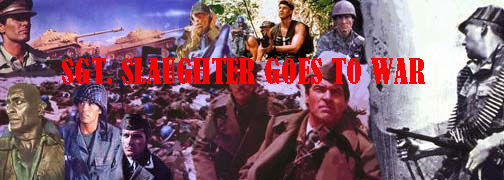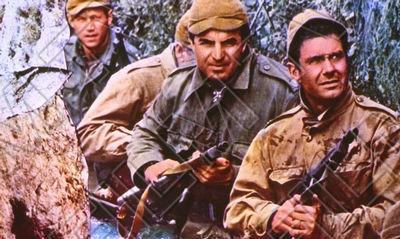
THE DEVIL'S BRIGADE (1968)
DIRECTOR:
Andrew V. McLaglen
CAST:
William Holden, Cliff Robertson, Vince Edwards, Claude Akins, Jack Watson, Andrew Prine, Richard Jaeckel, Richard Dawson, Luke Askew, Tom Troupe, Michael Rennie, Dana Andrews, Carroll O'Connor, Norman Alden, James Craig, Patric Knowles, Paul Busch, Max Tarilli and Gerard Herter.
REVIEW:
With the huge – and I mean huge – success of “The Dirty Dozen” in 1967, both in the US and abroad, a popular theme began to appear in war movies: instead of focusing on good, clean-cut heroes, the main characters became misfits thrown into situations which made them heroes, whether they wanted to be or not. The story of the Devil’s Brigade is a true one about misfits turned into heroes in wartime.
William Holden (“Alvarez Kelly”) plays Lt. Col. Frederick, who derives a plan for combining Canadian and American troops into an assault force which will attack the Germans in Norway. His superiors find the plan so good that they assign him to carry it out. Holden is forced to deal with two contingents of troops: a proud, professional Canadian unit under the command of proud, career soldier Major Crown (Cliff Robertson, “The Naked and the Dead”) and an American unit comprised of misfits and criminals, led by Major Bricker (Vince Edwards, “The Victors”). The men instinctively hate each other, and spend their months of training bickering with one another, until a huge bar fight forces them join forces against unappreciative lumberjacks. From there, the men are no longer fighting each other… they are deployed to Italy, rather than Norway, where they must capture a strategic hilltop from which Nazi artillery pounds the Allied advance.
Veteran director McLaglen, who seems to always be able to throw together a satisfying film but never really made a classic, falls short once again – this time, he’s trying to make a docudrama, but constantly falls back on established stereotypes and familiar situations rather than fresh, new material, almost as if he’s afraid to try something new. That aside, this is one very entertaining movie, and its’ success rests largely on the capability of a huge cast of character actors.
Of the three leads, Robertson is most convincing. He manages to make Major Crown an admirable hero, with guts and determination. He cares about his men but pushes them to their limits because he knows that when they face the Wehrmacht, they will be better off for it. He is calm and collected under pressure, whether it is pressure from superior officers, attitudes of the men under his command or in the tense heat of battle. Likewise, Edwards breathes vibrant life into Major Bricker. Bricker is a witty officer with a short temper towards misbehavior in his unit, and little respect for the dregs he commands. We know he’s unhappy with his assignment from the moment we meet him; only gradually does his attitude change. Holden is actually the least believable of the three leads. He never seems to be acting with much passion or concern for his character, and never comes across as a real, living human being. His role as commander is strictly one-dimensional, and this is probably the lowest-grade role I’ve seen him in to date. This is where flaws in the script begin to take their toll, because most viewers have seen Holden act so much better, but that’s because he’s had much better material to work with.
The supporting cast is filled with familiar faces, several of which deserve mention because they are so good. Claude Akins (“Merrill’s Marauders”) plays Pvt. Rockman, easily the most rebellious of the Americans. He’s physically rough, has a dirty mouth towards the Canadians and many of his fellow Americans, and won’t hesitate to pick a fight with anyone, anywhere. But during the aforementioned bar fight, he finds himself Allied with Cpl. Peacock (Jack Watson, “Tobruk”), the one Canadian he holds in highest contempt. Peacock is a staunch, stiff NCO who makes discipline and respect his #1 priorities, and naturally, he and Rockman don’t get along… until they have to fight alongside each other to gain respect from some angry lumberjacks, and realize that maybe they can get along as comrades in arms, and maybe even friends. The course of this relationship builds realistically throughout the course of the entire film, making one scene during the final battle incredibly moving.
Also providing fine turns in the supporting cast are Andrew Prine, Richard Jaeckel, Jeremy Slate, Richard Dawson, Tom Troupe, Luke Askew, and Jean-Paul Vignon as key members of the brigade. The big names – Michael Rennie, Dana Andrews, and Carroll O’Connor – have brief appearances as American Generals, and don’t leave much of an impression. Fans of Euro-war flicks will notice Max Tarilli and Paul Busch as German officers atop the mountain, and surprisingly enough, Gerard Herter appears unbilled as a German General who has his entire garrison taken prisoner while he takes a bath! And, yes, that IS Karl Otto-Alberty as a German interrogator.
McLaglen makes the final act, consisting of two major encounters with the Germans, the highlights of the film. The first major encounter involves the brigade’s probe of a German village, in which they manage to capture an entire German battalion without taking a single casualty. This scene is funny and well-executed, but never comes across as a very convincing – it’s simply meant to be a humorous excursion, and proves that the men of the Devil’s Brigade can operate better than any other American Army unit. The on-location filming looks great in this sequence, though – it was shot in a real village, not on a set, and the exteriors look fresh in every shot. McLaglen uses a lot of pans and zoom-outs to show the progress of his characters, too, making for some nicely composed scenes.
The final battle atop Mount la Difensa is brilliantly executed from start to finish. Beginning with a perilous sequence of the brigade rappelling up steep cliffs, the sequence builds to a bloody, hand-to-hand encounter with German infantry. Most of the battle is shot from the grunts’ perspective, and the camera occasionally rises above the action to show us what progress the men have made – but essentially, this isn’t an epic battle with a bunch of extras battling it out. McLaglen is interested in telling a human drama from the start, and doesn’t abandon his characters in favor of scope. Instead, he tells the story of the fight as the men see it, and does a very good job. When compared to films of today, the final battle isn’t very graphic, but does feature plenty of blood spurts and there is some use of a hand-held camera, making this a bit more realistic than some other war films of the time period.
“The Devil’s Brigade” is a touching human drama, but easily fades into the sea of familiar unit pictures. There is nothing to really set this apart from that sea, but director McLaglen and the actors work well together, making the story riveting and enjoyable. There are ample doses of humor and satisfying amounts of humor, action and character drama to make this a recommendable war film.
SGT. SLAUGHTER’S RATING:
4 Bullets




